Master the Technique of Searing Steak on the Stove
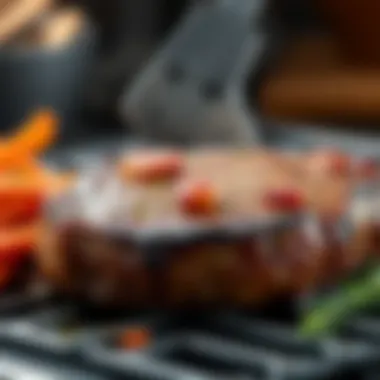
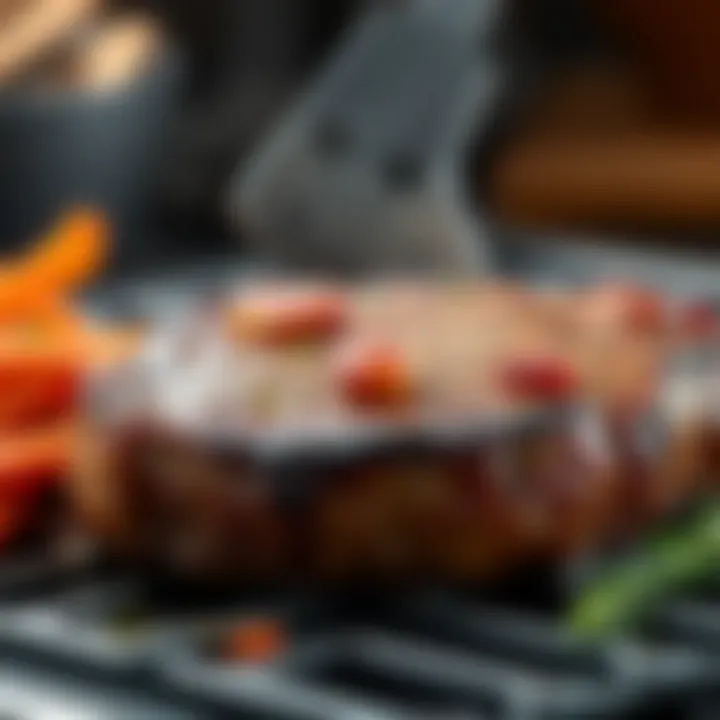
Intro
Understanding the principles behind searing involves a bit of science. When meat hits a hot surface, a reaction called the Maillard effect occurs. This chemical reaction is responsible for that appealing brown crust that adds depth of flavor. Gaining insight into the preparation, tools, and techniques will pave the way for success.
As we dive into this guide, you will discover essential preparation steps, the tools that make a difference, and detailed methodologies for achieving the perfect crust. It's practical information designed for food lovers of all ages—be it a novice eager to impress or a seasoned cook looking to perfect their skills.
With every twist and turn, this guide offers not just how-to instructions but also nuggets of wisdom to enrich your cooking journey. So, roll up your sleeves and prepare to elevate your searing game. Let's get started!
Prelude to Searing Steak
Searing steak is more than just a cooking method; it’s a culinary cornerstone that adds depth and complexity to this prized cut of meat. Many enthusiasts regard this technique as nothing short of an art form. What makes searing so significant? It harnesses high heat to lock in flavors, leading to that coveted crust that gives each bite a delightful textural contrast.
Understanding Searing
At its core, searing is about creating a Maillard reaction, a fancy term for the browning that occurs when proteins and sugars in the steak interact under high heat. This not only turns the surface a beautiful golden brown but also produces an array of complex flavors. Instead of simply cooking a piece of meat, you're transforming it into something far grander. The sear is the first step in a multi-layered flavor experience that tantalizes the palate.
Furthermore, a proper sear can mean the difference between a tender, juicy piece of steak and a dry disappointment. When steak hits a hot pan, it begins to caramelize on the surface, forming a barrier that helps retain moisture within. This is why achieving that perfect sear is paramount for any home cook aiming for restaurant-quality outcomes.
Importance of Technique
Skillful searing isn’t solely a matter of throwing meat in a pan and hoping for the best. Proper technique is essential. Heating the pan adequately, seasoning appropriately, and timing your flips are all crucial elements. Mastering these aspects ensures an even sear without compromising the internal doneness of the steak.
Consider the classic misstep of overcrowding the pan. When multiple pieces of meat are crammed together, they cool the pan down, creating steam instead of a sear. This not only affects texture but also leads to uneven cooking—nobody wants that!
Here are some additional considerations that can elevate your searing game:
- Temperature Control: Knowing when to turn down the heat ensures you don’t burn the outside while the inside remains raw.
- Oil Selection: The choice of oil matters; some oils have higher smoke points, better suited for high-heat cooking.
- Equipment Quality: The right pan can drastically affect how well your steak sears.
“A well-seared steak can turn a regular meal into a gourmet experience.”
Selecting the Right Cut of Steak
Choosing the proper steak cut can feel a bit like searching for hidden treasure. The quality and type of meat you opt for can dramatically affect both the flavor and texture of your final dish. This choice sets the stage for your searing experience and can mean the difference between a steak that's just okay and one that leaves taste buds dancing.
When selecting a steak, it’s important to consider not just the cut but what it brings to the table, so to speak. Each cut has unique qualities that influence how it cooks and what kind of flavor you can create. Moreover, some cuts are naturally more forgiving when searing, while others require a bit more finesse. The goal here is to find a balance between personal preference, cooking technique, and desired outcome.
Popular Steak Cuts
Steak comes in an array of cuts, each with its own distinct characteristics:
- Ribeye: Known for its rich marbling, ribeye often offers the most flavor due to the higher fat content. This cut melts beautifully during cooking, making it a favorite for steak lovers.
- Sirloin: More lean than ribeye, sirloin still delivers an excellent flavor. It’s a versatile cut that holds up well to grilling and pan-searing alike.
- Filet Mignon: This cut is exceptionally tender and buttery, however, it has less fat than its marbled counterparts. If you’re after tenderness, it’s hard to beat the filet.
- New York Strip: With a balance of tenderness and fat, this cut provides a robust flavor and satisfying chew, making it popular for many home cooks.
- T-Bone: Combining the tenderness of the filet on one side and the flavor of the strip on the other, the T-bone is perfect for those who want a little variety.
Selecting the right cut often comes down to personal taste and desired cooking results, so don't shy away from experimenting with various options.
Quality Factors to Consider
When it comes to beef, quality is key. Knowing what to look for can help ensure that your searing experience is as beautiful as you’d hope. Here are the critical elements to help guide your cut selection:
Marbling
Marbling refers to the small flecks of fat interspersed within the muscle of the steak. Higher marbling typically indicates a higher quality cut.
- The presence of marbling in cuts like ribeye can enhance intra-muscular fat, resulting in a juicier, more flavorful outcome.
- Although some might think a leaner steak is healthier, it’s often the marbled cuts that harmonize well with heat, allowing them to cook evenly and retain moisture better.
A good amount of marbling not only contributes to flavor but also affects overall texture during cooking, making it a sought-after quality among steak enthusiasts.
Thickness
Thickness plays a role in how a steak cooks during the searing process.
- Generally, a steak that is about 1.5 to 2 inches thick gives you more room for control when cooking.
- Thicker steaks take longer to reach desired internal temperatures, and this allows for a more substantial flavor development through searing.
- However, steaks that are too thick can pose a challenge, leading to the outside becoming overcooked before the inside reaches the desired doneness.
Opting for a steak with the right thickness can significantly impact the final execution of your sear.
Freshness
Freshness simply tells you how recently the meat was cut from the animal and processed. A fresher cut not only tastes better but can also influence the searing process.
- Ideally, you want a steak that’s been properly stored and has a bright color, indicating good health and quality.
- Fresh steaks typically have a much more pronounced flavor and texture when cooked compared to those that have been sitting around for too long.
- Pay attention to the smell and appearance; freshness can drastically improve the quality of your final dish.
Choosing a fresh cut ensures you’re starting with the best, which sets a strong foundation for crafting an unforgettable steak.
"The right cut of steak is the canvas; the searing is the art."
Taking the time to select the right cut based on these factors is essential for mastering the sizzling sear you’re aiming for. Making informed decisions at this stage primes you for success in the kitchen.
Essential Equipment for Searing
When it comes to searing steak, having the right equipment is just as significant as mastering your technique. The proper tools not only facilitate the cooking process but also ensure that your steak achieves that coveted crust while maintaining juiciness inside. Each piece of equipment serves a distinct purpose and influences the final result, making your choice of gear pivotal in delivering a satisfying dining experience.
Choosing the Right Pan
Cast Iron Skillet
A cast iron skillet is like an old friend who always delivers when called upon. Its ability to retain and evenly distribute heat makes it a standout choice for searing steak. One might say the skillet's durability is its key characteristic; it can withstand high temperatures without warping, which is crucial for achieving that well-formed crust. The unique feature of a cast iron skillet is its natural non-stick surface that improves over time with seasoning.
However, there are some factors to consider. While cast iron skillets are excellent for high heat cooking, they can be a little heavy and require a bit of maintenance to keep them in top condition. This is a small price to pay for anyone serious about achieving steak perfection.
Stainless Steel Options
On the flip side, stainless steel pans also earn high marks in the world of steak searing. The shiny exterior and quick responsiveness to temperature adjustments make it easy to control the cooking process. A prominent aspect of stainless steel pans is their ability to develop fond, the delicious brown bits that stick to the surface. This is a delightful addition if you plan on creating a pan sauce.
While they are generally lighter than cast iron, stainless steel options may not retain heat as well, which means you’ll have to watch the temperature more closely to avoid uneven cooking. Nonetheless, they're versatile and easy to clean, making them another solid investment for your kitchen.
Utilizing Proper Heat Sources
Gas vs Electric
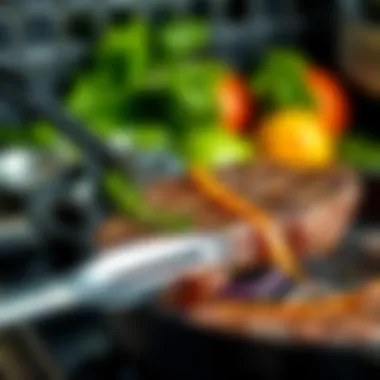
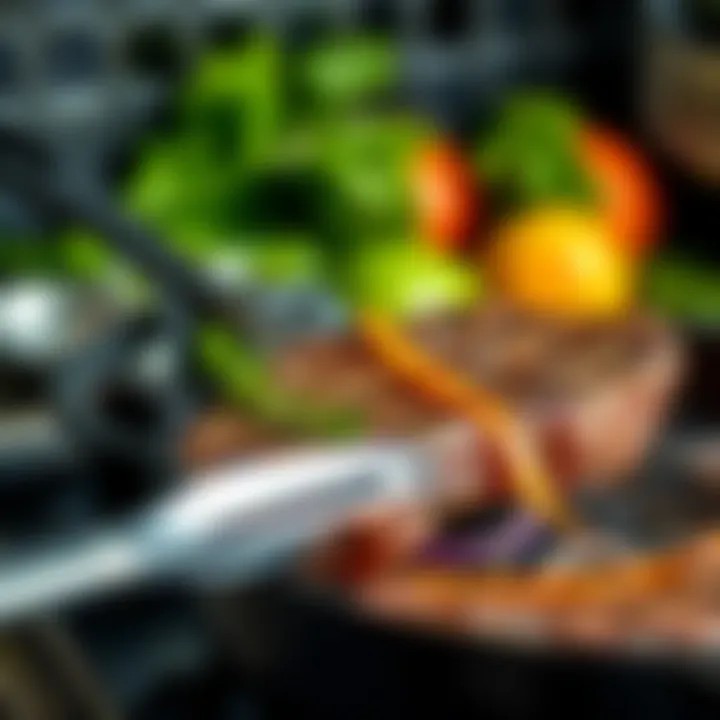
When it comes to the type of heat source, the debate between gas and electric has been ongoing for ages. Gas ranges offer instant heat control, allowing you to quickly adjust flames as needed during the cooking process. This immediate response is a major advantage, especially when searing steaks, as it gives you the opportunity to develop that perfect crust without burning.
However, some may argue that electric stoves can provide steady and consistent heat, beneficial for even cooking. But they typically take longer to heat up. If you enjoy the precision that comes with gas cooking, it might be best to stick to that method for your steak searing.
Induction Cooktops
On the other hand, induction cooktops are growing in popularity among culinary enthusiasts. Utilizing electromagnetic energy, these cooktops heat up pots and pans directly rather than the cooktop itself, contributing to faster cooking times and improved energy efficiency. The precise temperature control provided by induction stoves can also help prevent overcooking, a crucial factor for searing steaks.
While induction cooktops come with their own set of benefits, they’re predominantly compatible with ferrous pans, which can limit your choices. However, if you invest in the right cookware, you could find this method to be a game-changer.
Necessary Accessories
Tongs
Tongs act as the unsung heroes in the kitchen. Their long reach keeps fingers safely away from hot surfaces, and their grip lets you turn and flip the steak with ease. The key characteristic of a good pair of tongs is their strength and dexterity—pieces that can firmly grasp your steak will ensure you don't lose any precious juices when flipping it mid-sear. Another plus? They're versatile tools that can be used for various cooking tasks beyond just steak.
However, choose tongs carefully. Tools made from thin materials may not offer the control you need for heavier cuts. Look for tongs that are sturdy yet lightweight for the best balance.
Meat Thermometer
A meat thermometer is one gadget no steak lover should be without. This device provides an ace in the hole for gauging doneness, ensuring that your steak isn’t under or overcooked. The key characteristic of a good meat thermometer is its quick read time. Digital thermometers can deliver results in mere seconds, making them the preferred option for many enthusiasts.
Using a meat thermometer may add an extra step, but oh, the rewards can be sweeter than dessert. You're not just cooking; you're hitting the perfect target of juiciness every single time. Of course, the downside is that thermometers can sometimes need a battery replacement or calibration, but these moments are few and far between if well cared for.
"Success in cooking always comes from balancing technique with intuition. The proper equipment can help you master both!"
With the right pans, heat sources, and accessories, you're a step closer to mastering the art of searing steak. Choosing wisely will not only elevate your searing game but also bring joy to every bite you serve.
Preparation Steps for Searing Steak
Getting your steak just right doesn't just happen by accident. The preparation steps for searing steak play a crucial role in achieving that perfect crust and juicy interior. Neglecting any of these areas can lead to unsatisfactory results, making it essential to understand and master them.
The act of bringing the steak to room temperature, seasoning it thoughtfully, and applying oil correctly can make a noticeable difference in the final dish. Together, these steps lay the groundwork for an exquisite searing experience. Each detail prepares the steak not just for cooking but for a flavorful ride that enhances the overall dining experience.
Bringing Steak to Room Temperature
Starting with a cold steak is generally a rookie mistake. Bringing your steak to room temperature allows for a more even cooking process. When a steak is cold, the outside may sear perfectly, while the inside remains chilly and will require longer cooking times, which can make it tough and less flavorful.
To reach room temperature, remove the steak from the fridge at least 30 minutes before cooking. This will help it acclimate to the kitchen's warmth, ensuring that all parts of the meat are on a level playing field when it meets that hot pan. It might seem trivial, but this thoughtful step can change the end result significantly, allowing the seasoning to penetrate the meat better and ensuring that the sear hits the entire surface evenly.
Seasoning Techniques
Salt
Salt is more than just a flavoring agent; it's truly the backbone of seasoning in steak preparation. When used properly, it can enhance the natural flavors locked inside the meat. The key characteristic of salt is its ability to draw moisture from the steak, which then combines with the salt, reabsorbing into the meat to create a juicy and flavorful profile.
When applying salt, be generous but not overwhelming. A thicker cut will need more salt compared to thinner slices. The advantages of using salt become evident as heat works its magic during cooking; you get that wonderful crust and burst of flavor in every bite. On the downside, using too much salt or applying it too late can lead to an overly salty steak. The timing and amount are everything.
Pepper
Pepper, while often an overlooked seasoning, brings a distinct warmth and depth, complementing the steak's natural flavors beautifully. The piperine compound in pepper is responsible for its characteristic heat. A key trait of fresh cracked black pepper is its aromatic potential, which significantly enhances the aroma of the dish, making each bite a sensory delight.
The popular choice among chefs is to add pepper at various stages—before cooking for aroma and after cooking for a fresh punch. However, applying too much can easily overwhelm the dish, making it essential to strike a balance. It’s the subtle hints of pepper in the background, dancing with the salt, that really elevate the steak experience.
Other Spices
Other spices can certainly bring a creative twist to your steak, breaking the monotony, and adding layers of flavor. While not traditional, spices like smoked paprika or garlic powder can introduce unexpected flavors. These spices can enhance the sear, creating a more complex profile that charms the palate.
The unique feature of incorporating other spices is that they allow for flexibility in flavor profiles. They can play nicely with salt and pepper, enriching the experience. However, caution is advised—overusing them or mismatching flavors can muddle the dish, creating a confusing profile rather than the intended artistry of flavor.
Coating with Oil
Choosing the Right Oil
When it comes to searing steak, the choice of oil is paramount. High smoke point oils, like canola or grapeseed, are the top contenders because they can withstand the high temperatures required for searing without breaking down. The key characteristic of these oils is their ability to turn heat into perfect browning and flavor development without a burnt taste.
The right oil will facilitate that desired caramelization, enhancing the crust’s color and texture. Choosing an oil that has a flavor aligning with your steak is advantageous; for instance, avocado oil can add a subtle grassiness. However, less stable oils, like extra virgin olive oil, should be avoided due to their lower smoke point, which can lead to unwanted bitterness.
Oil Application Method
Once you've chosen the right oil, it’s crucial to apply it correctly. One common way is to drizzle it on the pan just before placing the steak. Alternatively, you can brush it on the steak directly. This method ensures that the oil is evenly distributed, creating an optimal surface for the maillard reaction—this is where the flavors deepen and create that beautiful crust.
Care should be taken not to drown the steak in oil as this can lead to steaming rather than searing, ultimately diminishing that sought-after crust. A thin, even coating goes a long way and will play its part in achieving culinary success.
From these thoughtful preparation steps, the groundwork for an impressive steak is laid, setting the stage for a delightful searing experience.
The Searing Process
The process of searing is central in achieving the perfect steak. This technique not only adds flavor but also seals in juices, creating a delectable crust that enhances the overall eating experience. A good sear can elevate the simplest cut of meat into a mouthwatering dish, making it essential knowledge for any home cook. Whether you are new to cooking or a seasoned chef, understanding the intricacies of the searing process can bridge that gap between an ordinary meal and a culinary delight.
Preheating the Pan
Before the steak ever makes contact with the pan, preheating is an invaluable step. This is crucial as it prepares the cooking surface to deliver high, consistent heat when it's time to sear. A properly heated pan helps to achieve that signature brown crust. Different types of pans have varied heat retention capabilities, with cast iron being a top choice due to its ability to hold and distribute heat evenly.
A sizzling sound upon laying the steak down is music to a chef's ears; it indicates that the meat is immediately reacting to the hot surface. To accurately preheat, you should let the pan sit over medium-high heat for several minutes. A drop of water should dance across the surface before evaporating if it’s appropriately heated.
Placing the Steak in the Pan
Once the pan is prepped, it’s time to lay the steak down, and this step is all about technique. Carefully placing the steak away from your body prevents splatters while keeping you safe from hot oil. Lay the steak down gently but firmly to avoid a steam effect, which would inhibit proper browning. The best way to do this is by tilting the steak onto one edge and rolling it in, keeping the surface contact intact. This ensures that each bit gets equal exposure to the heat.
Pay attention to the spacing too. Overcrowding the pan can reduce the temperature quickly, leading to steaming instead of the sought-after sear. Therefore, it’s wise to sear in batches if cooking multiple steaks.
Timing for Perfect Sear
Timing is key when it comes to searing steak. The magic often lies in the art of flipping the steak at precisely the right moment. An average steak takes about 3 to 4 minutes per side for medium-rare, depending on its thickness. The golden rule is not to touch the steak until it’s ready to flip. It will naturally let go of the pan surface once it’s developed that lovely brown crust.
Using a timer can keep you on track, but be sure to read the doneness by visual cues as well. Look for a deep brown color and a slight edge of caramelization. Mastering this balance of timing not only maximizes flavor but also ensures the texture remains succulent and enjoyable.
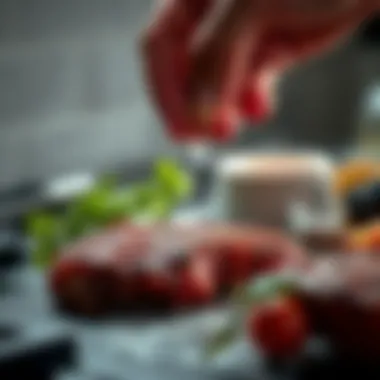
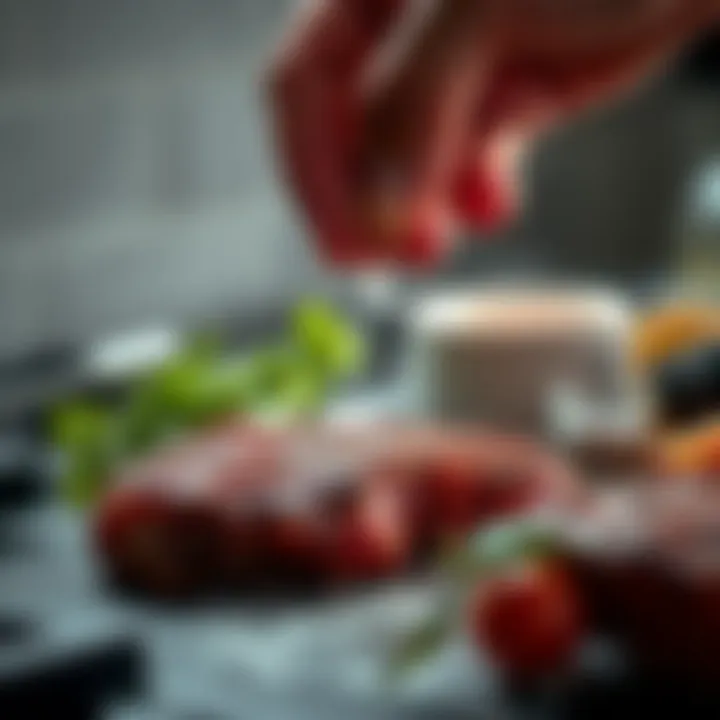
Important Note: The process may vary based on the pan or type of steak, so always adapt as needed and refer frequently to your meat thermometer to check temperatures.
Understanding these steps of the searing process will enrich your culinary skills and ensure your steak is not just cooked but perfected. As you embark on this journey of flavors and textures, remember that practice makes proficient. Enjoy the process, and don’t hesitate to experiment along the way!
Flipping and Monitoring Doneness
The art of flipping and monitoring the doneness of steak plays a pivotal role in mastering the stovetop searing technique. This stage not only demands a keen eye but also a measured approach to ensure that the steak achieves that coveted crust while remaining juicy inside. Mistakes in this area can lead to an overcooked steak that loses its flavor and texture. Thus, knowing when to flip and how to monitor the doneness can significantly elevate your cooking game.
Flipping Techniques
Use of Tongs
Using tongs for flipping steak is perhaps the most popular method for many chefs and home cooks alike. The main benefit of tongs lies in their ability to securely grip the steak without piercing it. This is important because piercing the meat allows juices to escape, leading to a dry final product. Tongs give you control, letting you turn the steak over with ease and precision.
One of the unique features of tongs is their design. They typically have a wide grip, which helps in handling thicker cuts. The simplicity of use is coupled with the fact that they can be used one-handed, making the flipping process seamless. However, one disadvantage that can arise is when the steak is particularly slippery; if too much force is used, you could accidentally send your steak flying out of the pan.
Determining the Right Time to Flip
To master the flip, timing is everything. Knowing when to turn your steak can be a game changer. Ideally, you want to flip your steak once a good crust has formed, which usually takes about 3 to 5 minutes, depending on the heat of your stove. The key characteristic of this timing is that it promotes even cooking on both sides, which is essential for achieving that perfect sear.
Another unique feature in finding the right moment is listening for that sizzle; it’s a great auditory cue that indicates your steak is cooking properly. The downside, however, is that beginners may find it challenging to gauge the exact doneness without the right experience. An excellent strategy to overcome this is to employ the “look, listen, and feel” method; observe the browning, listen to the cooking sounds, and feel the texture of the steak as it cooks.
Checking Internal Temperature
Using a Meat Thermometer
A meat thermometer is an indispensable tool for checking the internal temperature of steak, allowing for precision cooking. This gadget takes the guesswork out of determining whether your steak has reached the desired doneness. The beauty of using a meat thermometer is its ability to provide instant feedback; you insert it into the thickest part of the steak to get an accurate reading without altering the cooking process.
The prominent feature of this tool is that it can adapt to various cuts of meat and cooking styles, making it versatile. However, one downside is that if the thermometer is not correctly placed, it could give an inaccurate reading. Thus, understanding how to use it effectively is key for any culinary enthusiast.
Understanding Temperature Ranges
Understanding the internal temperature ranges is crucial for achieving the right doneness of your steak. The standard ranges are:
- Rare: 120°F to 125°F
- Medium Rare: 130°F to 135°F
- Medium: 140°F to 145°F
- Medium Well: 150°F to 155°F
- Well Done: 160°F and above
This knowledge allows you to plan your cooking time more effectively and ensures that your steak turns out just the way you desire. The key characteristic of these ranges is the precision they offer, allowing critical assessments of your cooking progress. However, the downside is that if you’re not careful, a few degrees off can result in a less-than-desired steak experience.
Allowing the Steak to Rest
Allowing the steak to rest is a crucial step in the cooking process that cannot be overlooked if you want to enhance flavor and tenderness. Many people, in their eagerness to dig in, skip this step entirely. However, this can lead to a less satisfying experience. When a steak is cooked, the juices within it are forced toward the center due to the heat. If you slice into a steak immediately after cooking, all those flavorful juices will spill out onto the plate, resulting in a dry and less appealing piece of meat.
Why Resting is Crucial
When a steak rests, it gives these juices time to redistribute throughout the meat. Think of it like giving the steak a little time-out. The heat gradually diminishes, allowing the muscles to relax, which in turn helps the juices to settle. If the steak is cut too soon, it might resemble a scene from a horror movie, with juices flowing everywhere. Nobody wants that! Instead, allowing it to rest leads to a more succulent and flavorful bite. Additionally, resting helps with the overall texture. The meat fibers relax, leading to a tender bite, not something that chews like a well-worn tire!
"Resting is not just a luxury but a necessity for perfectly cooked steak."
How Long to Rest
The resting time can vary based on the size and thickness of the steak. As a general rule of thumb, a steak should rest for about 5 to 10 minutes. For thicker cuts, like a ribeye or porterhouse, it may be best to let it rest a bit longer, around 10 to 15 minutes. During this time, you can prepare your sides or perhaps set the table—consider it a well-deserved break for your steak before the grand presentation on the plate.
Here’s a quick guideline for resting:
- Steak less than 1 inch thick: 5-7 minutes
- Steak around 1 inch thick: 8-10 minutes
- Thick steaks (over 1 inch): 10-15 minutes
Serving and Enjoying Your Sear
Once you’ve perfected the searing process, the next crucial step is how to serve and fully appreciate your creation. Serving steak isn’t just about putting it on a plate; it’s a fine balancing act between the visual appeal, flavor enhancement, and the overall eating experience. By focusing on both serving suggestions and slicing techniques, you elevate the dining experience, making it memorable for both you and your guests.
Serving Suggestions
Pairings
When it comes to serving steak, pairing it with the right accompaniments is vital. Think about what complements the rich flavor of the meat. Common pairings that enhance the steak experience include roasted vegetables, creamy mashed potatoes, or even a fresh salad drizzled with vinaigrette. These foods not only provide balance but also bring out the umami notes in your steak.
Key characteristic: The ideal pairing should play off the steak's flavor profile while also considering texture. For instance, a buttery, soft side dish can nicely contrast the steak's crust, creating a symphony of tastes. Using seasonal ingredients can often elevate the meal as well.
Unique feature: Say you opt for grilled asparagus or roasted Brussels sprouts—these vegetables lend a smoky note that can beautifully complement the sear of the steak. However, beware of overpowering flavors. You want to accentuate, not overshadow, that glorious crust you've worked so hard to achieve.
Presentation Techniques
How you present your steak can significantly affect the enjoyment of your dish. Consider the plate you choose—something simple yet elegant often works best. A white plate allows the deep char of the steak to pop and draws the eyes to the beautiful crust. Spreading some sauce on the plate before laying down the steak can add an artistic touch while enhancing flavors.
Key characteristic: A well-plated steak encourages anticipation and appetite. Using fresh herbs like rosemary or thyme as a garnish not only adds visual appeal but also hints at the flavors within.
Unique feature: Consider serving slices of steak fanned out on the plate instead of just placing the whole piece down. This presentation invites your guests in, showcasing the cookery and inviting discussion about the preparation process. Remember, a visually appealing plate can make the meal more enjoyable, stimulating hunger through both aesthetics and scent.
Slicing Techniques for Optimal Enjoyment
Now let’s talk about those slices. How you slice your steak can greatly impact its tenderness and your enjoyment. Always cut against the grain—this breaks up the muscle fibers and makes each bite easier to chew. A common mistake is to slice with the grain, which can lead to tough, chewy pieces that mar the whole experience.
Pro tip: Use a sharp knife to make clean cuts, minimizing any tearing of the meat. Aim for about half an inch to an inch in thickness for your slices.
"Cooking is not just about making food; it's about crafting an experience worth savoring."
By taking the time to consider these elements, you'll make sure that both you and your guests can fully appreciate the fruits of your labor.
Common Mistakes and How to Avoid Them
When it comes to searing steak, even minor missteps can lead to a less than stellar meal. This section dives into some of the most common pitfalls cooks encounter, aiming to shine a light on how a few small adjustments can elevate your steak game. Understanding these mistakes not only helps in avoiding them but also enhances your overall cooking skills. Let’s dig in.
Overcrowding the Pan
A crowded pan is like trying to fit a square peg in a round hole; it just doesn’t work well. When you place too many steaks in your skillet, you lower the temperature significantly. Instead of achieving that beautiful, caramelized crust, you end up steaming the meat.
To avoid this, cook one or two pieces at a time depending on the size of your skillet. A hot, dry environment is paramount for proper searing. Remember: if it doesn’t sizzle when it hits the pan, it’s probably too crowded.
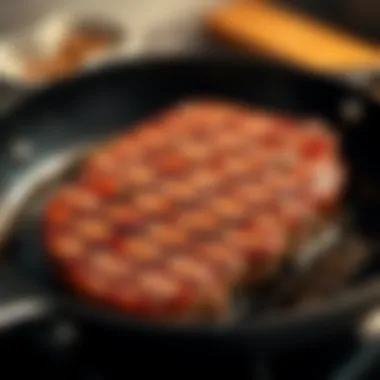
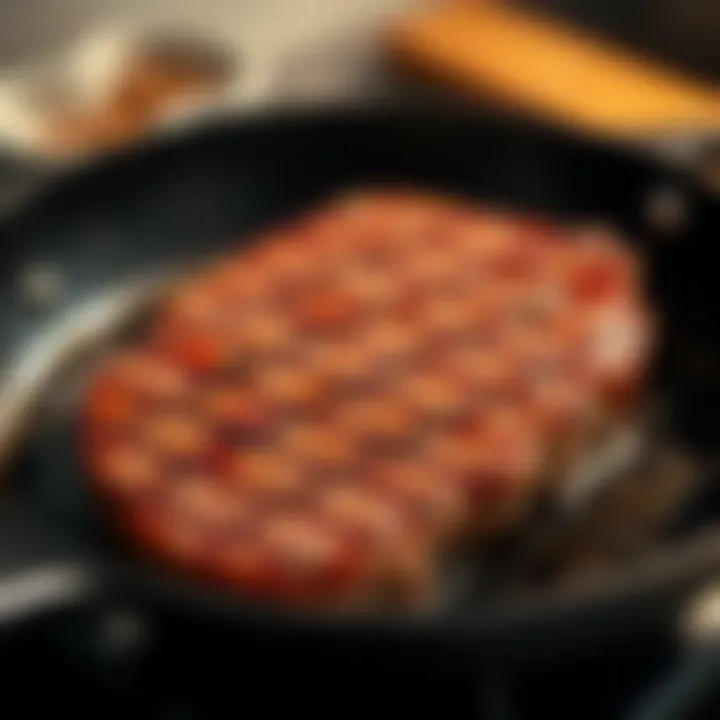
Inadequate Seasoning
In the culinary world, seasoning can make or break a dish. If you skimp on salt and pepper, your steak could taste bland, despite having been cooked to perfection. Think of seasoning as the foundation on which all flavors build; it’s essential to enhancing the natural taste of the meat.
Here are a few pointers:
- Generously season with coarse kosher salt at least 30 minutes before cooking. This allows the salt to penetrate and elevate the flavor layers.
- Pepper can be tricky. Too much can be overwhelming, but not enough may leave your steak flat. A light dusting on both sides works wonders,
Incorrect Cooking Temperature
As any seasoned chef will tell you, heat is your ally—but only if you wield it correctly. Cooking at too low of a temperature may leave your steak rubbery and unappetizing, while cooking it too hot might scorch the outside before the inside is properly cooked.
To find that sweet spot, follow these steps:
- Preheat your skillet. A well-preheated skillet will help create that sought-after crust. Always test with a droplet of water; if it sizzles, you’re good to go.
- Know your heat source. Gas stoves may heat differently than electric ones, so adjust accordingly. Experimentation is key!
"Cooking is not just about following a recipe; it’s about understanding the ingredients, the heat, and the process."
In summary, the journey to a perfectly seared steak is riddled with common mistakes that, when recognized, can be effectively avoided. By paying attention to pan overcrowding, seasoning inadequacies, and proper cooking temperatures, you can enjoy a steak that tantalizes the taste buds and impresses even the most discerning palates.
Advanced Techniques for the Enthusiast
When it comes to mastering the art of searing steak, some techniques set enthusiasts apart from the rest. These advanced methods don’t require unconventional gadgets or outlandish ingredients; they revolve around enhancing the flavors and the overall cooking experience. By honing these methods, culinary aficionados can achieve results that are not just palatable but transcendent.
Searing a steak is already about developing a superior crust and enhancing flavor, but using advanced techniques can elevate this experience further. They allow for deeper flavor infusion, a more enjoyable texture, and an overall enriching cooking journey. Let's delve into some specific techniques that every steak enthusiast should consider.
Basting for Enhanced Flavor
Basting, while simple in concept, can significantly amplify the flavor of your steak. The process involves spooning melted fat, typically butter, over the steak as it cooks. This technique not only keeps the steak moist but adds a richness that truly brings out the delicious profile of the meat.
- Choose Your Fat Wisely: Butter is a classic choice but don’t shy away from flavored options. Clarified butter, for instance, has a higher smoke point and infuses unique flavors.
- Add Flavor with Aromatics: Incorporating garlic, rosemary, or thyme into the butter while basting can dramatically transform the dish, inviting diverse notes to mingle with the meat's natural savor.
- Timing is Key: Start basting after the first minute or two of searing; this is the point when the meat's surface begins to develop that beautiful crust.
- Technique Matters: Use a spoon or baster to ensure even coverage, allowing the butter to seep into the crevices while creating a crunchy exterior.
Basting not only enhances flavor but also adds a beautiful glaze to the surface of the steak, making it visually appealing even before the first bite.
Using Herbs and Aromatics
Herbs and aromatics play a crucial role in elevating the overall depth of your seared steak. Fresh ingredients like rosemary, thyme, garlic, and even shallots can be introduced during the cooking process to infuse your dish with vibrant notes.
- Timing and Placement: Add herbs right after you place the steak in the hot pan. This allows the natural oils in the herbs to release, permeating the steak as it sears.
- Creating a Flavored Oil or Sauce: If you’re feeling adventurous, you can combine olive oil with sliced garlic and herbs to create a marinade. Let this mixture sit for a while or even drizzle it over your seared steak to provide an extra layer of flavors.
- Finishing Touch: After the steak has rested, artfully sprinkle some fresh herbs on top for that visually delightful presentation.
The key is to balance and harmonize the steak's natural flavors with those of the herbs, crafting a dish that tastes as wonderful as it looks. This method not only enhances the taste but can also elevate any meal from ordinary to extraordinary.
Utilizing herbs and aromatics brings a vibrant life to your steak that mere seasoning cannot achieve.
Nutritional Aspects of Steak
When delving into the culinary delight of steak, understanding its nutritional aspects becomes crucial. Steak not only satisfies the taste buds but also serves as a rich source of vital nutrients. Exploring the intricate details of its nutritional value provides insights into how this beloved dish can play a role in a balanced diet. Knowing the advantages and considerations surrounding steak’s nutritional components can elevate both meal satisfaction and health benefits for any food lover.
Understanding Nutritional Value
Protein Content
Steak shines as a formidable source of protein, often regarded as one of the most popular choices for those seeking to boost their protein intake. One of the key features of steak's protein content is its high-quality nature, which encompasses all essential amino acids that the body cannot produce independently. This makes it a superb alternative for individuals aiming to build muscle, recover from exercise, or simply maintain a healthy weight.
On average, a 3-ounce serving of cooked steak can yield approximately 25 grams of protein. This number highlights steak’s position as a beneficial protein source, especially when compared to other meat options.
However, it is worth mentioning that while protein is essential for numerous bodily functions, moderation remains key due to the potential for high saturated fat content in certain steak cuts. Opting for leaner cuts, like sirloin or flank, can alleviate this concern while delivering the protein punch sought after.
Vitamin Sources
In addition to being protein-rich, steak is abundant in vitamins that contribute significantly to overall health. Specifically, it serves as an excellent source of B vitamins, particularly vitamin B12. This vitamin plays a pivotal role in red blood cell formation and neurological functions, emphasizing its importance in maintaining a healthy body and mind.
Moreover, steak also provides other essential vitamins like niacin and riboflavin, which support energy production and metabolic processes. Incorporating steak into your meals can thus aid in ensuring adequate vitamin intake, aligning with dietary needs.
It's important to be mindful of the preparation methods used when cooking steak, as they can influence the nutritional quality. Grilling or oven-roasting may help retain more nutrients compared to methods that involve excessive oils or frying. In this way, you can enjoy all the disease-fighting properties of the vitamins found in steak without added complications from cooking techniques.
"Steak not only commands a spot on dining tables but also serves as a powerhouse of nutrients that can support a healthy diet—when approached correctly."
Being equipped with knowledge about the nutritional aspects of steak empowers food enthusiasts to make informed choices, transforming a simple meal into a wholesome experience. Taking into consideration both the protein and vitamin benefits, steak presents a well-rounded option for those wishing to indulge responsibly.
Food Safety Considerations
When it comes to cooking, particularly with meats like steak, addressing food safety isn’t just an afterthought—it's a crucial element from the get-go. Ensuring that your steak is cooked safely not only preserves the flavor but also protects your health. In this section, we delve into the essence of food safety, emphasizing its importance in our journey of mastering searing steak on the stove.
Safe Cooking Temperatures
One of the fundamental aspects of food safety is understanding safe cooking temperatures. It goes beyond merely aiming for a visually appealing crust; it’s about ensuring that harmful microorganisms are eradicated. Here’s a breakdown of what you need to remember:
- Minimum Internal Temperatures: USDA guidelines suggest that beef steaks be cooked to a minimum internal temperature of 145°F (62.8°C). For seasoned cooks wanting steak cooked to medium-rare, this value will resonate; however, once removed from heat, the steak should rest for at least three minutes. This resting period allows the internal temperature to rise a couple of degrees more, enhancing flavor and safety.
- Using a Meat Thermometer: A meat thermometer is not just a whimsical addition to your cooking toolkit; it’s an essential tool for any serious chef. Stick it into the thickest part of the steak, avoiding bone or fat, to get the most accurate reading. When cooking steak, the following temperatures can be useful:
- Cross-Contamination: Besides cooking temperatures, always be wary of cross-contamination. Ensure that surfaces and utensils used for raw steak are sanitized before coming into contact with cooked meat. Raw juice can hide pathogens that can lead to foodborne illnesses.
- Storage Safety: What you do before cooking matters, too. Keep uncooked steaks refrigerated at or below 40°F (4°C). They should ideally be consumed within a few days. If you’re not going to cook them right away, freezing them is a smart option. Just remember, when thawing, it’s best to do so in the refrigerator or in cold water, never on the counter.
- Rare: 125°F (51.7°C)
- Medium Rare: 135°F (57.2°C)
- Medium: 145°F (62.8°C)
- Medium Well: 150°F (65.6°C)
- Well Done: 160°F (71.1°C)
"Safe cooking is not just about flavor, it’s about health. Don’t let a momentary lapse ensure you’re left with food poisoning rather than succulent steak."
By adhering to these guidelines surrounding safe cooking temperatures and proper kitchen hygiene, you not only ensure a deliciously cooked steak but also protect yourself and those you love from foodborne illnesses. Food safety isn’t just another task; it’s a commitment to the joy of cooking.
The End and Final Thoughts
Searing steak is a craft that transcends mere cooking; it's an essential skill that can significantly elevate your culinary repertoire. This article has traversed the intricate landscape of steak searing, from understanding the fundamental techniques to selecting the right equipment. The journey through the various stages of preparation, cooking, and finishing touches has illuminated why the art of searing is worthy of your attention.
Exploring the importance of this method reveals that searing is not only about achieving a beautiful crust but also about locking in moisture and maximizing flavor. Each step, from bringing the steak to room temperature to letting it rest after cooking, plays a vital role in delivering a mouthwatering final product. Adhering to these principles guarantees a steak that is both visually appealing and supremely satisfying.
Key Elements of Searing
- Flavor Development: Searing creates a Maillard reaction, infusing the meat with delectable flavors that are hard to ignore.
- Texture Contrast: The contrast between the crispy outer layer and the tender interior enhances the overall dining experience.
- Visual Appeal: A well-seared steak isn’t just a treat for the palate but also for the eyes, making it the centerpiece of any meal.
Beyond these benefits, one must consider the commitment to mastering this technique. It requires a combination of patience, practice, and, importantly, a willingness to learn. Mistakes might happen along the way, but these are just stepping stones to becoming a better home chef.
As you embark on your own searing journey, be sure to remember that perfection is subjective. What might be a perfect sear for one could differ for another. So, engage with your ingredients, be present in the moment, and don’t shy away from experimenting.
"Cooking is like love. It should be entered into with abandon or not at all."
For further reading and resources on meat preparation and safety standards, you may find the following links useful:















